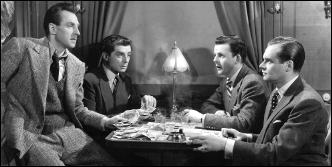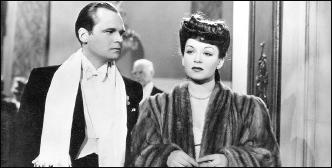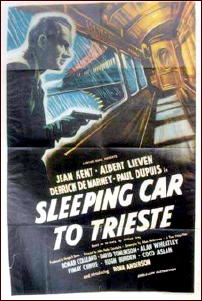Reviewed by DAVID VINEYARD:
ORRIE HITT – I’ll Call Every Monday. Red Lantern Books, hardcover, 1953. Avon #554, paperback reprint, 1954.

I got the impression that she was short because I could see a lot of one leg. It was straight and firm and rounded and not too long from the knee down to her foot. She had the accordion in her lap and this had pulled her dress up.
I was trying to think how I would describe Orrie Hitt’s writing style, and I went through quite a few ideas such as ‘post war spicy pulp’ or ‘hard-boiled soft-core,’ but I finally came up with the most accurate description I could think of.
Orrie Hitt wrote in paperback covers.
Read that passage above and tell me if you can’t see that cover by Avati, McGinnis, or Saber. The man wrote in paperback covers.
That’s not a knock. It’s a vivid and entertaining style with a flavor of the pulps but adapted to the post war hard-boiled paperback original industry he worked in. He isn’t a lost master, but he wrote professional readable books sometimes a bit above the average and there were actual plots between the not quite sex scenes.

It is difficult to remember how hot this was when written. Today it’s at worst frustrating. It’s the fifties juvenile kind of sex where the hero wants to see the girl naked, but he’s not quite sure what to do when she is. When anything actually does happen, you have to go back and reread the passage to be sure it did.
I’m not complaining that it is not more graphic, only pointing out that it is hard to believe you had to read this with a flashlight under the sheets or hide it in your treehouse from your parents.
This one was published by Avon. Beacon or Midwood were more often his style.
The hero of this one is Nicky Weaver, a bit of a drifter, the usual WWII veteran of popular fiction of the era.. As the novel begins he’s selling insurance in Devans a small town in upstate New York USA.

MONDAY IS A BIG day on an insurance debit. Monday is the day when the housewives hang out their wash, lie to every bill collector in town—and are thankful that they didn’t get themselves higher than a kite over the week-end.
If you get the idea early that Nicky is a poor man’s Walter Neff from Double Indemnity you wouldn’t be far off; the film version anyway with that mouthful of Chandleresque wiseacre observations; first person Smart Aleck. The girl with the accordion is a sweet kid who lives where he does.
She had on a dark blue dress and the way she was standing she was outlined against the window. She had high pointed breasts, a pulled-in middle that didn’t amount to anything, and a set of hips that drove the temperature in the room up to about a hundred and twenty.
That’s Sally, the accordion girl, and another paperback cover moment. There are several of them along the way with her and others.
The chief female in question appears shortly after. She has a husband and she’s buying life insurance on herself, for now. She’s Irene Shofield, wife of Shepard Shofield:

She was tall, about five-seven, and she looked like she had about a forty-inch bust. Her hair was blonde, almost to the point of being white, and it was held in place by a green scarf that came up through her curls and ended in a little bow on top. She wore yellow shorts that were plenty short and a halter of the same color that wasn’t holding up anything that couldn’t have stayed up by itself.
Irene does things to Nicky:
She sat up, bent forward and put the glass down on the ground beside the bench. Her halter was loose and I felt my temperature getting up to sunstroke stage.
As you might guess Shepard really needs life insurance. You see, in New York State if the wife is insured for over $1,000 the husband has to have coverage as well. That must have come as a surprise to Irene, such a thing would never occur to her. Whether that was true or not about the insurance, Hitt sells it and writes believably about what Nicky is all about, not only in his pants, but in his work. His attention to the details of the business weaving in and out around Nicky may remind you of John D. MacDonald, a lesser John D. MacDonald, but still.

The book moves well, is well plotted, and if no surprises it has no disappointments either. Hitt’s not in the class of a Ed Lacy, a Harry Whittington, or a Day Keene, and he’s a shade on the sleazy side, but he’s the king of what he did.
While Nicky struggles with his itch for the troubled close to illegal Sally and the seduction by the gorgeous Irene a colleague, Dell Waters, dies, and Dell told his wife that Nicky was a good guy who could help her, and of course she is attractive and represents the healthy side of Nicky’s libido. I can’t say she mourns very long though.
I watched her as she worked. Her arms were strong and brown and she handled the hook like she knew what she was doing… She worked with a slow rhythm that made her look cool even there in the hot sun. Once or twice she bent over to pull an old piece of wire out of the way. When she did that her blouse sagged in front. There was no doubt about her being all woman.
Bess and her kids are Nicky’s salvation, if Irene doesn’t drown him in desire and her plans. Irene is a shade on the sociopathic side. Barbara Stanwyck in Double Indemnity is pure as the driven snow compared to Irene.

There are a good many complications and situations for hot breathing and some panting with Sally, Bess, and especially Irene, and Irene will show her true colors with Nicky having to make the big choice between her and murder.
There’s even a plot and several sub-plots that don’t quite get in the way of the panting, but the tame sex that seldom gets beyond a kiss, a bit of groping, loose clothing, and the temperature of the woman-in-question’s body under her clothes. “Pointed breasts†is about as graphic as it gets. This is much tamer than anything in Spillane’s work, whatever kind of hound Nicky is.
The difference is the sex is really what this and most of Hitt’s books are about. The plot is incidental to that paperback cover style of writing.
It’s a fairly standard paperback original suspense novel, Hitt a bit better as a writer than some, at least enough to be memorable. If you didn’t already know that he was a collectible writer from the era, you would likely read another one by him. This one is what John D. MacDonald might have written if he was just a paperback original writer and not John D. MacDonald. It’s what people thought Gold Medal was giving them, when they were giving them so much more in most cases.

Something is missing though, and it escapes me exactly what it is. The same plot, the same level of writing in other hands didn’t feel trashy, and this does. I’m not saying it’s bad trash, though. I enjoyed it for the hour and fifteen minutes it filled. I’m just not sure I’ll remember much of it a month from now or be able to distinguish it from another Orrie Hitt book.
There is a mystery involved here as well. Sometime later Hitt wrote a book called Ladies’ Man. That book is in the third person and features a hero named Nicky Weaver who used to sell insurance and takes a job selling advertising for a small radio station in a new town, gets involved with a woman and a bit of embezzlement, and ends up a murderer being arrested as the book ends. If he’s the same guy, he’s bi-polar at the least.
I’ll leave that one for someone else to solve, but it’s also written in paperback covers.


